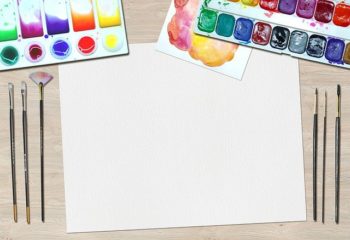Colloquial Spanish Course – Talking about Art in Spanish Posted by Laura & Adam on Mar 22, 2021 in Idioms, Language, Learning, Pronunciation, Spanish Grammar, Spanish Vocabulary
In this Spanish lesson we are going to practice talking about Art in Spanish. First we will learn some relevant vocabulary and then see if you can follow a short audio conversation in Spanish. The transcript to the audio will be given at the end of the post but please try not to look at it until you have tried playing and understanding the audio a few times.
Talking about Art in Spanish:
el aguafuerte – etching
el boceto, el esbozo – sketch
el bodegón, la naturaleza muerta – still life
el busto – bust
el caballete – easel
el carbón, el carboncillo – charcoal
el collage – collage
el dibujo – drawing
el diseño – design
el esmalte – enamel
el estudio – studio
el fresco – fresco
el grabado – engraving
el mosaico – mosaic
el paisaje – landscape
el paisaje marino – seascape
el pincel – brush
el subastador / la subastadora – auctioneer
el tapiz – tapestry
la acuarela – watercolor
la arcilla – clay
la cerámica – ceramics
la escultura – sculpture
la estatua – statue
la figura – figure
la obra maestra – masterpiece
la pintura al óleo – oil painting
la subasta – auction
la talla de madera – wood carving
la pintura – paint
el lienzo – canvas
el pincel – paintbrush
el pigmento – pigment
bosquejar, esbozar – to sketch
los óleos – oil colours
el acrílico colora / colores de acrílico – acrylic colours
los colores pastel – pastel colours
los creyones – crayons
un retrato – a portrait
arte abstracto – abstract art
arte moderno – modern art
arte conceptual – conceptual art
Now play the audio to listen a conversation. Can you understand what is being said? Play the audio a few times before you look at the transcript. Don’t worry if you don’t understand every single thing the two people are saying. Try to catch whichever words you can and then try to piece things together to work out what is being said.
(Play the audio a few times before you scroll down and look at the transcript)
Transcript:
Harry: Hola Maite, ¿cómo te va con tu clase de arte?
Maite: Me gusta. Aunque la clase de la semana pasada fue un poco extraña.
Harry: ¿Por qué, qué pasó?
Maite: Tuvimos un modelo desnudo.
Harry: Oh, vaya. ¿Era la primera vez que pintabas a alguien desnudo?
Maite: Sí. Y no solo tuvimos que hacer una pintura. Nos pidieron que hiciéramos un boceto, una pintura y una escultura del hombre.
Harry: ¿Cuánto tiempo tardaste en hacer todo eso?
Maite: Toda la sesión, tres horas. Y continuamos en la siguiente clase para terminar las esculturas. La verdad es que no lo no pasé nada bien. Prefiero la naturaleza muerta y el arte conceptual.
Harry: Por cierto, todavía tengo tu pintura al óleo en mi casa.
Maite: Oh, qué bien Harry. Me alegro de que te guste.
Harry: Está muy bien. Eres buenísima con acuarelas y óleos.
Maite: Mi nueva pasión es la cerámica. Voy a una clase los miércoles.
Harry: Me gustaría hacer eso.
Maite: Me encanta trabajar con arcilla. Es muy versátil y encuentro el proceso muy relajante. Deberías apuntarte. Te lo recomiendo.
Harry: No sé, creo que no soy muy artístico.
Maite: La cerámica no es como dibujar o pintar. Es una técnica y un estilo de arte completamente diferente. Nunca sabrás si eres bueno o si te gusta la cerámica a menos que pruebes.
Harry: Me gusta trabajar con madera y metal. Tallado y moldura. Creo que me puede gustar la cerámica.
Maite: Hablaré con la maestra mañana y le preguntaré si puedes venir la semana que viene.
Harry: Está bien, perfecto. Gracias Maite.
So, how did you get on? How much did you understand of the listening? Please let me know in the comments section below…
Don’t worry if you didn’t understand that much, keep reviewing the vocabulary and phrases and you will soon be up to speed and ready for the next lesson in this course. See you next time!

Build vocabulary, practice pronunciation, and more with Transparent Language Online. Available anytime, anywhere, on any device.




